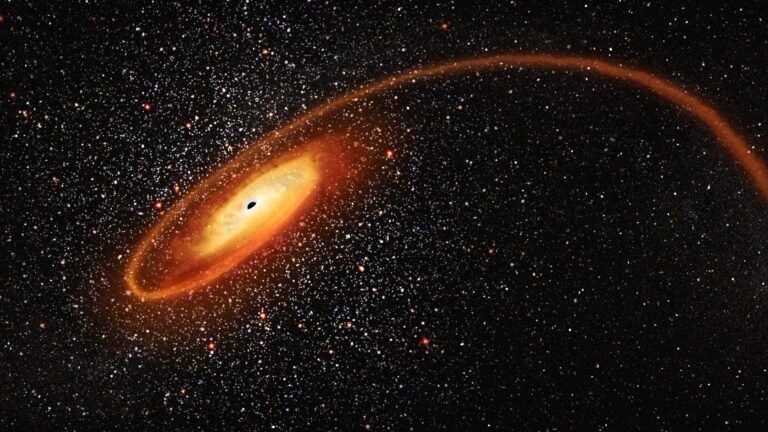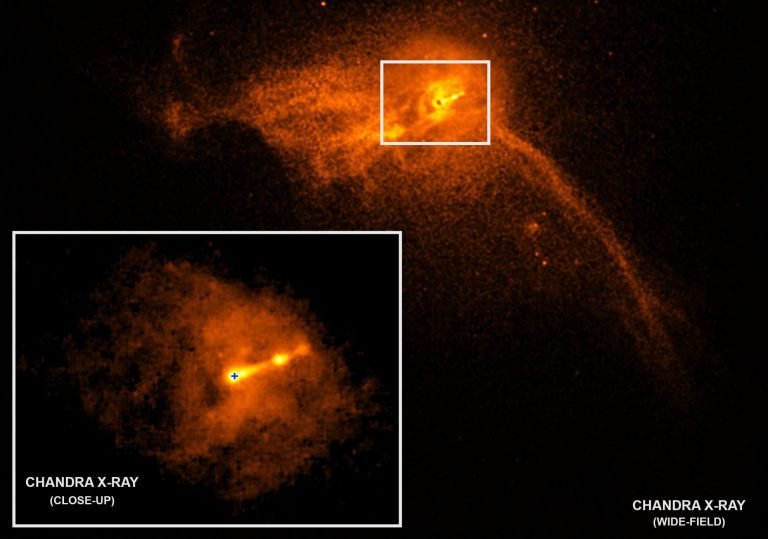A black hole isn’t just a hole in the ground. Rather, it’s a vast amount of stuff compressed into a small space – imagine a star 10 times more massive than the Sun crammed into a sphere the size of New York City.
As a result, nothing, not even light, can escape the gravitational field. NASA equipment has created a fresh image of these unusual objects in recent years, which are considered by many to be the most interesting things in space.
●⫸ What is A black hole?
A black hole is a region of space in which gravity is so strong that even light cannot escape. Because stuff has been crammed into such a small space, gravity is extremely powerful. When a star is dying, this can happen.
People cannot perceive black holes because no light can escape. They are undetectable. Space telescopes equipped with specialized equipment can aid in the discovery of black holes.
Special instruments can observe how stars close to black holes behave differently from other stars.

We can’t see what’s inside a black hole because no light – or any other sort of information – can escape. But astrophysical theories predict that, at the center of a black hole, all the black hole’s mass is condensed into a small point of infinite density. A singularity is a name given to this moment.
The black hole’s extraordinarily intense gravitational field is generated by one point — this singularity. Consider the possibility that the singularity does not exist.
That’s because, in the severe circumstances found at the heart of a black hole, all known physics breaks down, with quantum phenomena undoubtedly playing a big role.
It is difficult to explain what truly exists at the heart of a black hole since we do not yet have a quantum theory of gravity.
●⫸ Who proposed the theory of Black Holes?
For millennia, people have imagined an object in space that is so big and thick that light cannot escape. Black holes were first predicted by Albert Einstein’s general theory of relativity, which demonstrated that when a massive star dies, it leaves behind a small, dense remnant core.
The equations showed that if the mass of the core is greater than three times that of the Sun, gravity will overwhelm all other forces, resulting in a black hole.
Karl Schwarzschild, a German scientist, and astronomer suggested the contemporary concept of a black hole in 1915 after finding a perfect solution to Einstein’s general relativity approximations.
Schwarzschild realized that mass may be compressed to an endlessly tiny point. Nothing – not even massless photons of light – would be able to escape its curvature as a result of this.
The event horizon is the point at which a black hole begins to fade into oblivion, and the gap between this boundary and the infinitely dense center – or singularity – is named after Schwarzschild. All masses, in theory, have a Schwarzschild radius that can be computed.
The Sun’s mass would generate a black hole with a radius of little under 3 kilometers if it was squashed into an endlessly tiny point (about 2 miles). Similarly, the mass of the Earth would have a Schwarzschild radius of only a few centimeters, resulting in a black hole a little larger than a marble.
●⫸ Different types of Black Holes and How they form:
The tiniest black holes, according to scientists, emerged when the universe was created. When the core of a massive star collapses in on itself, it creates a stellar black hole. A supernova is produced when this occurs.
A supernova is a star that explodes and sends a piece of itself into space. Supermassive black holes, according to scientists, formed at the same time as the galaxy in which they reside.
The leftovers of a massive star that dies in a supernova explosion produce the majority of black holes. (Smaller stars decay into dense neutron stars, which lack the mass to confine light.)
It can be demonstrated theoretically that no force can protect a star from collapsing under the pull of gravity if the entire mass of the star is great enough (about three times the mass of the Sun).
However, something unexpected happens when the star crashes. As the star’s surface approaches an imaginary line known as the “event horizon,” time on the star slows in comparison to time measured by observers far away.
Time stops when the surface hits the event horizon, and the star can no longer collapse – it becomes a frozen collapsing object.
As a result of star collisions, even larger black holes can form. The intense, transient flashes of light known as gamma-ray bursts were seen shortly after NASA’s Swift telescope launched in December 2004.
After collecting data from the event’s “afterglow” with Chandra and NASA’s Hubble Space Telescope, scientists concluded that tremendous explosions may occur when a black hole and a neutron star meet, resulting in the formation of another black hole.

Although a form of the small black hole has been proposed, it has never been detected. They’re considered to have been created when the early Universe’s rippling vacuum expanded rapidly, forcing particularly dense places to collapse in a phenomenon known as inflation.
They’d be called primordial black holes, and they’d have a lesser mass – some as little as Earth’s – yet be around the size of a jelly bean. Black holes were merely a mathematical curiosity until the 1970s. Then, in 1971, astronomers found Cygnus X-1, the first physical black hole.
●⫸ Main Parts of a Black Hole:
Although the basic creation process is well established, one enduring enigma in black hole research is that they appear to exist on two dramatically different scales.
On one hand, there are innumerable black holes formed by the collapse of huge stars. These “stellar-mass” black holes are 10 to 24 times as massive as the Sun and may be found all around the Universe.
When another star approaches close enough for some of the stuff around it to be snared by the black hole’s gravity and churn off x-rays, astronomers may see them.
The majority of star black holes, on the other hand, are extremely difficult to detect.
Scientists predict that there are as many as ten million to a billion such black holes in the Milky Way alone, based on the number of stars massive enough to form them.
The “supermassive” black holes, which are millions, if not billions, of times as massive as the Sun, are on the other extreme of the size range.
Supermassive black holes, according to astronomers, are found at the center of nearly all major galaxies, including our own Milky Way. Astronomers can spot them by observing the impact they have on neighboring stars and gas.
●⫸ Major Black Holes:
Black holes can be very large or very tiny. The tiniest black holes, according to scientists, are as small as one atom. These black holes are really small, but they have the bulk of a mountain. The quantity of substance, or “stuff,” in a thing is measured in mass.
“Stellar” black holes are a different type of black hole. It has a mass that is up to 20 times that of the sun. In Earth’s galaxy, there might be a large number of star mass black holes. The Milky Way is the name of our galaxy.
The most gigantic black holes are referred to as “supermassive.” These black holes have a combined mass of almost a million suns. Scientists have discovered confirmation that in the heart of every giant galaxy lies a supermassive black hole.
Sagittarius A is the name given to the supermassive black hole at the heart of the Milky Way galaxy. It has a mass of around 4 million suns and would fit inside a massive ball large enough to house a few million Earths.
Astronomers have long held the belief that no mid-sized black holes exist. Recent data from Chandra, XMM-Newton, and Hubble, on the other hand, supports the argument for the existence of mid-sized black holes.
A chain reaction of star collisions in tight star clusters leads to the production of extremely massive stars, which eventually collapse to generate intermediate-mass black holes, according to one theory.
After then, the star clusters descend to the galaxy’s center, where the intermediate-mass black holes merge to produce a supermassive black hole.
🟤 Stellar-mass Black Holes:
There are three different kinds of black holes that we are familiar with. The first kind is a black hole with a stellar mass. These are the shards of massive stars that once shone brightly.
When a star with a mass greater than five times that of our sunbursts as a supernova after its life, gravity compresses its core fiercely. Depending on the mass of the star, the collapse may come to a standstill, becoming a neutron star.
However, if the core’s mass is adequate, it will continue to collapse, becoming a black hole. The masses of stellar-mass black holes range from around five times the mass of our sun to about 60 times the mass of our sun. They usually have a diameter of 10 to 30 kilometers (16-48 km).
🟤 Intermediate Black Holes:
In 2021, researchers revealed the finding of a black hole of intermediate mass. This form of black hole spans the gap between stellar-mass black holes and supermassive black holes lurking at galaxies’ centers.
55,000 suns are the mass of the recently found “goldilocks” black hole. The researchers discovered the intermediary black hole by detecting signals from a gamma-ray burst, which were detected far behind it. Scientists discovered the intermediate-mass black hole after gravitational lensing of the burst’s light.
🟤 Supermassive Black Holes:
The supermassive black hole is the third form of a black hole found in the universe. They might be billions of suns in mass. The centers of most galaxies, according to astronomers, contain supermassive black holes.
Sagittarius A*, the galaxy at the heart of our own Milky Way, has 4 million times the mass of our sun and a diameter of 37 million miles. At the heart of the quasar known as TON 618 lies another example of a supermassive black hole.
Its black hole at the center is estimated to be 66 billion solar masses. Although the exact genesis of supermassive black holes is unknown, they are thought to have evolved in the early history of the cosmos from vast collapsing clouds of interstellar hydrogen.
🟤 The fourth form of Black Holes exists:
Another type of black hole, known as a tiny black hole, may exist. These would be far smaller than a black hole of stellar mass. They are still merely speculative at this point, and none have been shown to exist.
●⫸ Conclusion:
With telescopes that detect x-rays, light, or other kinds of electromagnetic radiation, scientists are unable to study black holes directly. However, we can deduce the existence of black holes and study them by seeing their impact on the adjacent matter.
A black hole passing through a cloud of interstellar matter, for example, will accrete matter inward. When a regular star approaches a black hole, it undergoes a similar process. In this situation, as it pushes the star closer to itself, the black hole has the potential to break it apart.
As the attracted matter speeds up and warms up, x-rays are sent into space. Recent discoveries provide compelling evidence that black holes have a profound impact on their surroundings, generating intense gamma-ray bursts, eating neighboring stars, and encouraging the creation of new stars in certain locations while halting it in others.

